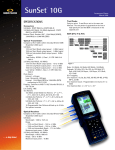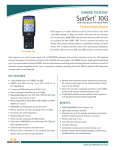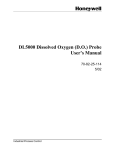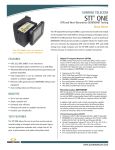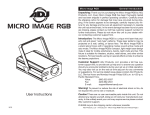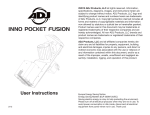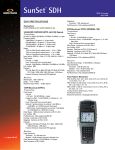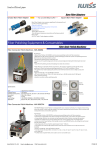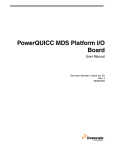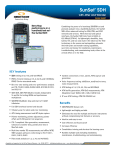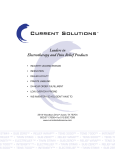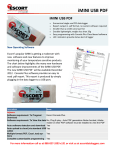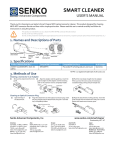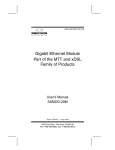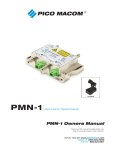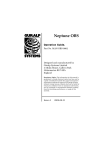Download APC-7000 Polishing System User Manual
Transcript
Photonic Components, Inc. APC-7000 Polishing System User Manual Revision D August 2003 “We provide superior solutions for global fiber connections” APC-7000 THIS DOCUMENT IS PROVIDED ONLY FOR APC-7000 CUSTOMER USE © 2002 Photonic Components, Inc. All Rights Reserved. This document is for informational purposes only, and the Company assumes no responsibility for any errors or omissions in this document. Photonic Components reserves the right to make changes to specifications and product descriptions at any time, without notice, and shall have no responsibility for conflicts or incompatibilities arising from such changes, and makes no commitment to update the information contained herein. The information in this document is current only as of the date of release of this document. Photonic Components makes no warranty for the use of its products, other than those expressly contained in the Company’s standard warranty provided as part of Photonic Component’s Sales Terms and Conditions for such products. PCI has granted to Buyer rights to use the APC-7000 only as specifically set forth in this manual and for no other purposes; and PCI reserves all rights not expressly granted herein. Without limiting the generality of the foregoing, PCI is and shall remain the owner of all right, title and interest, including copyright, trademark, patent and all other intellectual property rights, in and to the APC-7000 and any software or components related thereto or incorporated therein; and no such ownership rights are transferred to Buyer hereunder. TO THE MAXIMUM EXTENT PERMISSIBLE UNDER APPLICABLE LAW, IN NO EVENT SHALL PCI OR ITS AFFILIATES BE LIABLE TO BUYER OR ITS AFFILIATES FOR ANY SPECIAL, INCIDENTAL, INDIRECT OR CONSEQUENTIAL DAMAGES OF ANY NATURE, INCLUDING WITHOUT LIMITATION LOST PROFITS, BUSINESS INTERRUPTION, OR LOSS OF BUSINESS INFORMATION, EVEN IF PCI OR BUYER OR THEIR AFFILIATES SHALL HAVE BEEN ADVISED OF THE POSSIBILITY OF SUCH DAMAGES. THE FOREGOING SHALL APPLY REGARDLESS OF WHETHER SUCH LIABILITY SOUNDS IN CONTRACT, TORT, NEGLIGENCE, STRICT LIABILITY OR ANY OTHER THEORY OF LIABILITY. PHOTONIC COMPONENTS, INC. and APC-7000 and APC-7000TM are trademarks of Photonic Components, Inc. All other trademarks, service marks or trade names referred to in this manual, including without limitation 3–IN-ONE ® (The WD-40 Company) are the property of their respective owners. 2 of 62 MAN-7000 Rev D August 2003 Contact Information Title: (PCI logo black.eps) Creator: Adobe Illustrator(R) 8.0 Preview: This EPS picture was not saved with a preview included in it. Comment: This EPS picture will print to a PostScript printer, but not to other types of printers. Sales Offices To locate the sales office that services your area, please visit the SENKO website at www.senko.com, or email [email protected]. Technical Support For all equipment or fixture related issues, including custom fixture development, contact: SENKO Advanced Components, Inc. 13741 Danielson Street, Suite F Poway, CA 92064 USA Tel: +1-858-623-3300 Fax: +1-858-623-3303 [email protected] SENKO Advanced Components (Euro) Ltd. 5 Fortuna Court, Calleva Park, Aldermaston, Berkshire RG7 8UB, United Kingdom Tel: +44 (0) 118-9821600 Fax: +44 (0) 118-9821900 [email protected] Polishing Process Development and Support Laboratory [email protected] For all polishing issues, recipe issues, or custom recipe development. For use by APC-7000 Customers ONLY 3 of 62 APC-7000 PCI Limited Product Warranty PCI warrants only the original buyer that all products, other than Software, made by PCI are free from defects in material and workmanship for a period of one (1) year from date of shipment. For this warranty to be valid, Buyer must register purchase with PCI pursuant to Warranty Registration. Under warranty, PCI will repair returned products or provide a replacement, at its own discretion, for any product made by PCI, which upon inspection by PCI are determined to be defective in material and/or workmanship within the above mentioned time frame. All products repaired or replaced under warranty are only covered for the remaining unexpired period of time in the original warranty for the particular defective product. These warranties shall extend to any product that has proven to be defective and has failed through normal use. However, the warranty excludes and does not cover any products or parts thereof which have been accidentally damaged, disassembled, modified, misused, used in applications which exceed their specifications or ratings, neglected, improperly installed, used with non-standard consumables or otherwise abused. Buyer must claim under the warranty in writing not later than thirty (30) days after the claimed defect is discovered. The Buyer must make all claims under this warranty and no claim will be accepted by any third party. Any warranty claims will require a maintenance log to show that maintenance was performed according to the schedule described in this manual. In the event that any tamper seals are removed or damaged, this warranty will be void. PCI will only accept returns for which an approved Returned Authorization Number (RMA) has been issued by PCI. Any returns must be shipped in the original container, or an approved replacement container provided by PCI. This warranty will be void if returns are made in any other shipping container. Buyer is responsible for all freight costs, duties, insurance and applicable taxes when shipping products pursuant to an approved RMA, including shipments from Buyer to PCI and shipments from PCI to Buyer. Where goods contain software (“Software”) PCI does not transfer ownership but only grants the Buyer a perpetual non-exclusive license to use Software, restricted only to use related to the operation of the products. Such license is transferable only with the transfer of ownership of the product in which it is used. Except to back up copies as permitted by law, Buyer shall not (i) modify, reproduce, copy, reverse engineer, decompile or disassemble all or any portion of the software, (ii) distribute, market, disclose, rent, lease or sublicense the use of the software to any third party, or (iii) permit or authorize anyone within Buyers reasonable control to do any acts in (i) or (ii). PCI warrants that the software under normal use and service as originally delivered to Buyer will function substantially in accordance with the function description set out in the product specifications and/or user manual supplied with for a period of ninety (90) days from the date of shipment. PCI’s sole liability and Buyer’s sole remedy for a breach of this warranty shall be PCI’s efforts in good faith to rectify the nonconformity. This warranty is void if Failure of the software has resulted from accident, misuse, abuse, misapplication or modification. As far as product performance is concerned, please note that PCI does not warranty any specific performance levels (due to differing factors as to fiber optic components used, consumables, etc.). Further, any claims made as to performance characteristics are based on 4 of 62 MAN-7000 Rev D August 2003 Title: (PCI logo black.eps) Creator: Adobe Illustrator(R) 8.0 Preview: This EPS picture was not saved with a preview included in it. Comment: This EPS picture will print to a PostScript printer, but not to other types of printers. the proper documented use of the products, as well as the exclusive use of PCI approved fiber optic components, PCI branded rubber pads and PCI branded polishing/grinding media. TO THE MAXIMUM EXTENT PERMISSIBLE UNDER APPLICABLE LAW, IN NO EVENT SHALL SENKO OR ITS AFFILIATES BE LIABLE TO BUYER OR ITS AFFILIATES FOR ANY SPECIAL, INCIDENTAL, INDIRECT OR CONSEQUENTIAL DAMAGES OF ANY NATURE, INCLUDING WITHOUT LIMITATION LOST PROFITS, BUSINESS INTERRUPTION, OR LOSS OF BUSINESS INFORMATION, EVEN IF PCI OR BUYER OR THEIR AFFILIATES SHALL HAVE BEEN ADVISED OF THE POSSIBILITY OF SUCH DAMAGES. THE FOREGOING SHALL APPLY REGARDLESS OF WHETHER SUCH LIABILITY SOUNDS IN CONTRACT, TORT, NEGLIGENCE, STRICT LIABILITY OR ANY OTHER THEORY OF LIABILITY. EXCEPT AS EXPRESSLY SET FORTH IN THIS LIMITED PRODUCT WARRANTY, SENKO MAKES NO, AND HEREBY EXPRESSLY DISCLAIMS ANY, REPRESENTATIONS OR WARRANTIES, EXPRESS OR IMPLIED, REGARDING THE APC-7000, OR THE OPERATION OR OTHER USE OF THE APC-7000, INCLUDING BUT NOT LIMITED TO ANY IMPLIED WARRANTY OF MERCHANTABILITY OR FITNESS FOR A PARTICULAR PURPOSE. PCI DOES NOT WARRANT THAT THE FUNCTIONS OF THE APC-7000 WILL MEET BUYER'S REQUIREMENTS OR THAT THE OPERATION OF THE APC-7000 WILL BE ERROR-FREE. For use by APC-7000 Customers ONLY 5 of 62 APC-7000 Warranty Registration Return the following registration information to PCI within 30 days after receipt of product to ensure valid warranty coverage. Photonic Components, Inc. APC-7000 Warranty Registration Company Name ______________________________________________________ Address 1 ______________________________________________________ Address 2 ______________________________________________________ City ______________________________________________________ State/Province __________________ Country ______________________________________________________ Zip/Postal Code __________________ Technical Contact Information Name ______________________________________________________ Email ______________________________________________________ Phone ________________ x ______ Fax __________________ Product Information Product Receipt Date _________________ Serial Number __________________ Email information to [email protected], or Fax this form to SENKO Sales at: +1-858-623-3303 Please complete registration within 30 days after receipt of product 6 of 62 MAN-7000 Rev D August 2003 Title: (PCI logo black.eps) Creator: Adobe Illustrator(R) 8.0 Preview: This EPS picture was not saved with a preview included in it. Comment: This EPS picture will print to a PostScript printer, but not to other types of printers. Revision History Revision C D For use by APC-7000 Customers ONLY Date March 2002 August 2003 Description - Updates to reflect v 3.0 software release (including adding separate coarse and fine load settings, added use of +/- key to select Setup Mode). - Added section 4 “Specifications” - Added requirements for partial fixture loading. - Expanded a number of sections. - Fold in user feedback - New style and formatting. -Updated Section 14 “Routine Maintenance” (including the addition of 15.2 “Calibration”, removal of 15.3 “Robotic Head Spindle Lubrication” and addition of 15.5 “Motor Hours Meter”) -Updated Section 11.4 “Setup Procedure For Proper Load” 7 of 62 APC-7000 Contact Information .................................................................................................................................... 3 PCI Limited Product Warranty.................................................................................................................... 4 1 Operator and Equipment Safety ........................................................................................................ 10 1.1 Safety Terms used in this manual.............................................................................................. 10 1.2 Selected Warnings..................................................................................................................... 11 2 Overview ........................................................................................................................................... 12 2.1 PCI Development and Evaluation Lab Support ........................................................................ 12 2.2 Important Terms used in this Manual........................................................................................ 13 3 Introduction ....................................................................................................................................... 14 4 Specifications .................................................................................................................................... 18 4.1 Product Specifications............................................................................................................... 18 4.2 Polishing Specifications ............................................................................................................ 19 Table 4.2 – Single Fiber Polishing Geometry Specifications ................................................................... 19 Table 4.3 – Ribbon Fiber Polishing Geometry Specifications.................................................................. 19 5 Receiving and Unpacking ................................................................................................................. 21 5.1 Repacking prior to Moving or Shipping ................................................................................... 22 6 Installation ......................................................................................................................................... 23 6.1 AC Power .................................................................................................................................. 23 6.2 Water Source ............................................................................................................................. 23 6.3 Waste Water Drain .................................................................................................................... 24 7 Initial System Checkout .................................................................................................................... 25 8 Operating the Controls ...................................................................................................................... 26 8.1 Locked State & Unlocked State ................................................................................................ 26 8.2 Keypad Functionality ................................................................................................................ 26 8.3 Data Entry.................................................................................................................................. 28 8.4 Password.................................................................................................................................... 29 8.5 Screen Contrast.......................................................................................................................... 30 8.6 Menu Navigation Flowchart...................................................................................................... 31 9 Understanding Recipes...................................................................................................................... 32 9.1 Elements of a Recipe................................................................................................................. 32 9.2 Programmed vs. Manual Recipe Elements................................................................................ 34 10 Creating /Editing Recipes.............................................................................................................. 35 11 Running an Automated Polishing Cycle ....................................................................................... 37 11.1 Balanced Fixture Loading Patterns ........................................................................................... 37 11.2 Setup Procedure for Proper Load .............................................................................................. 38 11.3 Preparation................................................................................................................................. 41 11.4 Polishing.................................................................................................................................... 45 12 Manual Polishing........................................................................................................................... 48 12.1 Preparation................................................................................................................................. 48 12.2 Manual Polishing....................................................................................................................... 49 13 Guide to Proper Polishing ............................................................................................................. 50 14 Polishing Pressure ......................................................................................................................... 51 15 Routine Maintenance..................................................................................................................... 51 15.1 Periodic Cleaning ...................................................................................................................... 52 16 User Notes ..................................................................................................................................... 53 Appendix A Maintenance Log............................................................................................................... 54 Appendix B Fixtures Available for the APC-7000 Polishing System................................................... 55 Appendix C – Related Products that support the APC-7000 Polishing System ................................... 57 8 of 62 MAN-7000 Rev D August 2003 Title: (PCI logo black.eps) Creator: Adobe Illustrator(R) 8.0 Preview: This EPS picture was not saved with a preview included in it. Comment: This EPS picture will print to a PostScript printer, but not to other types of printers. Appendix D SENKO Brand Consumables for use with the APC-7000 ................................................ 58 Appendix E – Balanced Fixture Loading Patterns ............................................................................... 59 For use by APC-7000 Customers ONLY 9 of 62 APC-7000 1 Operator and Equipment Safety The APC-7000 has been designed to provide safe operation when used in the manner in which it was designed and by an operator following the instructions provided in this manual. The APC-7000 uses rotating machinery and robotic moving parts that are exposed to the operator. It uses AC Mains electrical power, and also uses both water supply and drain. As with all equipment using rotating machinery and robotic moving parts, the APC-7000 presents risks to the operator including the risk of serious injury, loss of limb and loss of life. As with all equipment that uses both AC Mains electrical power and water, there is the risk of electrocution. All reasonable precautions have been taken in the design of the APC-7000 to ensure operator safety, including: ? ? Grounded AC Mains power source ? ? No user serviceable components inside the housing ? ? Starting requires operator to use both hands to press separate start buttons ? ? Electrical components sealed from water areas Safe operation requires that all operators read and understand the instructions in this manual. Although all efforts have been made throughout this manual to highlight risks and dangers, there can be no assurance that other risks don’t exist, and that dangerous situations could not be created. Safety information provided here is for the Operator, Engineer or any other person handling, using or maintaining the APC-7000. Safety warnings and cautions relating to proper usage are also found throughout this manual in the applicable sections. 1.1 10 of 62 Safety Terms used in this manual WARNING Identifies conditions or practices that could result in personal injury or loss of life to the operator or others. CAUTION Identifies conditions or practices that could result in damage to the equipment or other property. MAN-7000 Rev D August 2003 Title: (PCI logo black.eps) Creator: Adobe Illustrator(R) 8.0 Preview: This EPS picture was not saved with a preview included in it. Comment: This EPS picture will print to a PostScript printer, but not to other types of printers. 1.2 Selected Warnings WARNING Equipment must be connected to AC Mains with a known good safety ground as described in Installation. Electrical cord must be maintained in good condition WARNING Electrical Shock Hazard if cover is removed. There are no user adjustments or user serviceable components inside. If cover is removed for any reason, unit must be physically disconnected from AC Mains. WARNING Crushing of finger or hand by the robotic head or attached fixture if any body part is located above the water tray or forward of the front edge of the water tray anytime a polishing step is in progress. WARNING Catching of body part or loose clothing in the rotating elements (including the platen, turntable and any items sitting on or attached to them) anytime a polishing step is in progress. For use by APC-7000 Customers ONLY 11 of 62 APC-7000 2 Overview This manual is written for the engineer or technician who is responsible for installation and maintenance of the APC-7000, as well as the operator using the equipment. It provides all the necessary information for installation, daily use and periodic maintenance. Repair information and software upgrade information is not provided. These actions must be performed by factory authorized service personnel and are outside the scope of this manual. PCI provides a series of Fixtures that attach to the APC-7000 and hold different types of components. These are supplied separately along with instructions for their use. Polishing recipes are provided with each fixture, for each type of component. If the unit is being unpacked and installed for the first time, follow the instructions starting in section 5 Receiving and Unpacking. If the equipment is subsequently moved or shipped, follow the instructions provided for re-packing and subsequent unpacking. Each time the equipment is installed or re-installed, follow in sequence the instructions in section 6 Installation and section 7 Initial System Checkout prior to operating the equipment for production purposes. Operation of the controls is described in section 8 Operating the Controls. The APC-7000 uses recipes to partly automate the polishing process. These are described in section 9 Understanding Recipes and section 10 Creating/Editing Recipes. With all the earlier sections providing background, section 11 describes how to perform automated polishing, and section 12 manual polishing Section 13 provides key information on how to obtain the best polishing results. Routine Maintenance information is provided in Section 14, Routine Maintenance. A place for you to make notes is provided in section 15 User Notes. Then, when a new version of this manual is published, you can easily transfer your notes. Appendices attached at the back of this manual list the Fixtures and Consumables that are available at the time of publication of this manual. 2.1 PCI Development and Evaluation Lab Support PCI evaluates new components on the market and, on a regular basis, develops fixtures and polishing recipes for all major manufacturer’s components. In addition to fiber connectors and ferrules, this includes components such as glass capillaries, v-groove arrays, specialty metals and others. In addition, PCI develops custom fixtures and recipes for custom component applications. PCI maintains a Polishing Process Development and Support Laboratory for custom recipe development, and to provide assistance to customers with their polishing and/or recipe problems. 12 of 62 MAN-7000 Rev D August 2003 Title: (PCI logo black.eps) Creator: Adobe Illustrator(R) 8.0 Preview: This EPS picture was not saved with a preview included in it. Comment: This EPS picture will print to a PostScript printer, but not to other types of printers. 2.2 Important Terms used in this Manual CRITICAL Indicates that this action or step must be followed to prevent unacceptably poor polishing results. REMINDER Important reminder about operating the Polisher. Repeated from the Safety section: CAUTION Identifies conditions or practices that could result in damage to the equipment or other property. WARNING Identifies conditions or practices that could result in personal injury or loss of life to the operator or others. For use by APC-7000 Customers ONLY 13 of 62 APC-7000 3 Introduction Congratulations on your purchase of APC-7000 Polishing System! This model from PCI is part of the growing family of solutions that PCI is known for: “We provide superior solutions for global fiber connections”. The APC-7000 Polishing System is designed for polishing fiber connectors in either a production or laboratory environment, to meet both low volume and high volume demands. Connectors polished on the APC-7000 exceed industry standards, and the design of the product ensures a high degree of repeatability and reliability in the finishing of connectors. Pre-programmed recipes control polishing duration and application of water. Once set up for a specific connector type, the operator can achieve consistent, high-quality results. Its rugged design allows it to be quickly set up and operated in production environments. Minimal maintenance is required, allowing the APC-7000 to meet rigorous factory up-time needs. Key features of the unit are presented in Table 3.1. Table 3.1 – Key Features of the APC-7000 Polishing System 14 of 62 ?? Polishing Performance Quality of polished connectors exceeds Geometry Specifications as described by Telcordia GR-326-CORE (Sept. 1999 Issue). ?? Interchangeable Fixtures Polishing fixtures, designed for handling specific connector types, are quickly loaded or removed. ?? Supports all major connector types LC/UPC, MU/UPC, SC/UPC, FC/UPC, ST/UPC, SC/APC, FC/APC, E2000-APC, E2000-UPC, MT-RJ, MT, Angled MT. ?? Specialty applications PCI designs fixtures for specialty applications. ?? Operator Convenience Robotic head rises between polishing steps, allowing operator to easily change rubber and polishing films. ?? Operator Safety Two-button start requires two hands, ensuring safe placement of hands during descent of head and fixture. ?? Ease of Operation In production environments, pre-programmed recipes provide consistent results when operated by lesser skilled personnel. Once set up, the operator only needs to change polishing films and rubber as instructed by the recipe. ?? Full range of capabilities Highly skilled users can fine tune factory recipes or create their own. ?? High Productivity Up to 36 fiber optic ferrules or 24 connectors can be polished simultaneously. ?? Water Built in, programmable water jet to automate rinsing of particles and contaminants between and during each polishing step. ?? Pressure Manually adjustable with coarse and fine controls. ?? Recipe Selection Front panel selection. MAN-7000 Rev D August 2003 Title: (PCI logo black.eps) Creator: Adobe Illustrator(R) 8.0 Preview: This EPS picture was not saved with a preview included in it. Comment: This EPS picture will print to a PostScript printer, but not to other types of printers. ?? Control system Automatically sets polishing duration and water spray on/off duration. ?? Monitoring LCD Readout shows current processing step and time remaining. ?? Recipe Programming Front panel input, recall, review and editing of 14 stored recipes. ?? Security Recipe parameters are password protected. The APC-7000 Polishing System is a self-contained unit that runs under microprocessor control. The components of the APC-7000 are shown in Figures 3-1 and 3-2. The Turntable is powered from a motor located in the Base, which drives the Removable Platen in a dual concentric pattern at a programmed speed. The rubber pad, glass plate or grinding plate is mounted by the operator onto the platen. It is captured and held by the platen’s tabs, which extend upwards to form a “cup”. Polishing Media (typically film) is used with either the rubber pad or glass plate, and is attached using either adhesive or water surface tension. For grinding, the grinding plate is used without any additional polishing media. A Fixture holds the Components securely in place while being ground or polished. Fixtures are specific to each type of component, with a wide selection available to handle all standard fiber connectors and ferrules. Fixtures are provided separately by SENKO. The Robotic Head Assembly holds the Fixture and travels vertically to engage the components with the Polishing Media. The Fixture is mounted on the fixture Spindle and attached by the Quick Mount/Dismount Chuck. The robotic motor located in the Base pulls the entire robotic head assembly down over three rigid guide columns. Contact force applied to the Fixture (and hence the components being polished) is determined by the degree of compression of the spring located in the robotic head when the head is down all the way. The Coarse Load Adjustment dial adjusts the head’s vertical position, which in turn changes the load on the spring when the head is in the down position. Fine load adjustments are made by the Fine Load Adjustment micrometer dial, which adjusts the pre-load compression on the spring. Built into the APC-7000 is a flexible-hose Water Directing Arm that can be pointed by the operator to direct a jet of water to a defined area. Water flow is controlled automatically by parameters in the recipe, or manually by pressing the Water Jet pushbutton. The rotating parts protrude through a watertight seal in the Polishing Platform. Underneath the polishing platform is the Water Tray, which acts as a catch basin into which runs water and grinding and polishing debris. The water tray uses a gravity drain, which exits the unit at the Waste Water Drain Connector. Sitting on the water tray is the Fixture Loading Tool, which the operator can use for loading and unloading components by placing and centering the Fixture on the tool. For use by APC-7000 Customers ONLY 15 of 62 APC-7000 Water Jet Nozzle Water Directing Arm Fiber Manager (Optional) Fiber Management Tray Coarse Load Adjustment dial Fine Load Adjustment micrometer dial Robotic Head Assembly Guide Columns (3 total; 1 behind not shown) Fixture Spindle (inside of chuck) Quick Mount/ Dismount Chuck Fixture Removable Platen Polishing Platform Turntable Water Tray Cycle Start Pushbutton Water Jet Pushbutton Keypad LCD Display Base Figure 3-1 – APC-7000 Polishing System (Front View) In place of the usual single start button, the APC-7000 has two Cycle Start Pushbuttons, which must both be pressed and held until the robot arm assembly is fully lowered into position. These two buttons are placed at a distance that requires the operator to use both hands, ensuring that fingers and hands are kept away from the fixture and the rotating components while in operation. Main AC power to the unit is controlled by the Main Power Switch. Control over the polishing parameters and selection and editing of recipes is done through the Keypad. Status and recipe readouts are displayed on the LCD Display. 16 of 62 MAN-7000 Rev D August 2003 Title: (PCI logo black.eps) Creator: Adobe Illustrator(R) 8.0 Preview: This EPS picture was not saved with a preview included in it. Comment: This EPS picture will print to a PostScript printer, but not to other types of printers. The APC-7000 supports 14 stored recipes. The recipe parameters are stored in non-volatile memory so that they are retained indefinitely even if the AC power is disconnected. Recipes are supplied by PCI and can be input in a matter of minutes by the operator. Once input, these recipes can be fine tuned as required. Additionally, the user can create recipes. Water tube from base to arm APC7000 Drain connectors (2) Water flow adjustment Fuse Main Power Switch AC Mains Power Connector Waste Water Drain Connector Water Inlet Connector Figure 3-2 – APC-7000 Polishing System (Rear View) For use by APC-7000 Customers ONLY 17 of 62 APC-7000 4 Specifications 4.1 Product Specifications Table 4.1 – Product Specifications Parameter Recipe Specification Units 14 Recipes Up to 9, user programmable Steps 0 to 999 Seconds 40 to 99 (95 and 99 reserved) Duro Universal -- 100-120/200-240 VAC 50/60 Hz Fusing 2 A, 250V, Slow-blow -- Outside Dimensions 10.5 W x 19 D x 23 H Inches Outside Dimensions 26.7 W x 48.3 D x 58.4 H Centimeters Weight 50 Pounds Weight 23 Kilograms Standard commercial pressure -- 80 to 120 Milliliters per minute 0.5 Micron 0.125 Inches 3.18 Millimeters 0.375 Inches 9.53 Millimeters Operating Temperature +10 to +40 Degrees C Storage Temperature -55 to +85 Degrees C Number of programmable recipes Number of polishing steps per recipe Polishing Step Duration Rubber pad resiliency range AC Power Type of Power Supply Voltage Line Frequency Mechanical Water Supply pressure Flow rate Filter Inlet connector diameter Drain connector diameter Environmental 18 of 62 MAN-7000 Rev D August 2003 Title: (PCI logo black.eps) Creator: Adobe Illustrator(R) 8.0 Preview: This EPS picture was not saved with a preview included in it. Comment: This EPS picture will print to a PostScript printer, but not to other types of printers. 4.2 Polishing Specifications The APC-7000 produces polished connectors that exceed the requirements per Telcordia GR-326-CORE (Sept. 1999 Issue) for optical connector geometry. Polished connectors will repeatedly meet the maximum values for geometric consistency per Table 4.2 Single Fiber Polishing Geometry Specifications and Table 4.3 Ribbon Fiber Polishing Geometry Specifications. In standard production environments, polished connectors will meet the typical values shown in these tables. Optical performance will repeatedly meet the values of Table 4.4, with typical values achievable in standard production environments. Table 4.2 – Single Fiber Polishing Geometry Specifications Typ Max Units Radius (for APC) GR-326 CORE Specification (Sept. 1999 Issue) (End-face geometry only) 5 = R = 12 6 = R = 10 5 = R = 12 Millimeters Radius (for UPC) Parameter 7 = R = 25 7 = R = 15 7 = R = 25 Millimeters Apex Offset < 50 < 25 50 Microns Fiber Height ± 50 ± 20 ± 50 Nanometers ± 0.15 ± 0.25 Degrees Ferrule End-face Angle Notes: - - “R” stands for “radius”. To achieve these values on a consistent basis, a properly trained operator must use the APC-7000 according to the instructions in this manual, using factory supplied recipes and SENKO brand consumables that are replaced on the appropriate schedule. Ferrule and connector quality can significantly affect these numbers. Table 4.3 – Ribbon Fiber Polishing Geometry Specifications Parameter Tilt (Long axis) Typ Max Units 0.15 0.25 Degrees Tilt (Short axis) 0.12 0.25 Degrees Fiber Height 1400 3000 Nanometers Adjacent Fiber Height 8 20 Percent Differential Fiber Height 11 20 Percent Notes: - - For use by APC-7000 Customers ONLY To achieve these values on a consistent basis, a properly trained operator must use the APC-7000 according to the instructions in this manual, using factory supplied recipes and PCI brand consumables that are replaced on the appropriate schedule. Ferrule and connector quality can significantly affect these numbers. 19 of 62 APC-7000 Table 4.4 – Optical Performance Specifications Parameter Insertion Loss @ 1310 and 1550 nm Insertion Loss Repeatability Return Loss Notes: - - 20 of 62 Connector Typ Max Units FC/APC 0.20 0.35 SC/APC 0.15 0.35 dB dB FC/UPC 0.13 0.30 dB SC/UPC 0.10 0.30 dB ST/UPC 0.25 0.35 dB MU/UPC 0.10 0.30 dB LC/UPC 0.10 0.30 dB MT-RJ 0.25 0.50 dB MTP-12 0.25 0.60 dB MPO-12 0.25 0.60 dB FC/APC 0.10 0.15 dB SC/APC 0.10 0.15 dB FC/UPC 0.07 0.10 dB SC/UPC 0.05 0.10 dB ST/UPC 0.12 0.15 dB MU/UPC 0.05 0.10 dB LC/UPC 0.05 0.10 dB MT-RJ 0.15 0.25 dB MTP-12 0.17 0.30 dB MPO-12 0.17 0.30 dB FC/APC - 68 - 60 dB SC/APC - 68 - 60 dB FC/UPC - 57 - 50 dB SC/UPC - 58 - 50 dB ST/UPC - 56 - 50 dB MU/UPC - 59 - 50 dB LC/UPC - 58 - 50 dB MT-RJ - 35 - 25 dB MTP-12 (Angle) - 54 - 50 dB MPO-12 (Angle) - 54 - 50 dB To achieve these values on a consistent basis, a properly trained operator must use the APC-7000 according to the instructions in this manual, using factory supplied recipes and PCI brand consumables that are replaced on the appropriate schedule. Ferrule and connector quality can significantly affect these numbers. MAN-7000 Rev D August 2003 5 Title: (PCI logo black.eps) Creator: Adobe Illustrator(R) 8.0 Preview: This EPS picture was not saved with a preview included in it. Comment: This EPS picture will print to a PostScript printer, but not to other types of printers. Receiving and Unpacking The APC-7000 is carefully packaged at the factory using specially designed shipping containers to prevent damage during shipment. When you receive your new APC-7000, inspect the shipping containers for damage prior to accepting delivery. Containers that show signs of damage may contain damaged product, and the shipping company should be notified immediately. SENKO Advanced Components, Inc. cannot be responsible for damage caused during shipping. A Shock Indicator is attached to the shipping container which indicates if the product was subjected to excessive shock levels (in excess of 40-60 “G”s) during shipping. Prior to opening the container, inspect the shock indicator. If the bidirectional arrow windows turn from red to blue, this indicates that the container and hence the product received excessive shock. The surface which received the shock is indicated by the arrow. Notify the shipping company immediately. Contact SENKO to arrange for the purchase of a replacement unit. A Tip/Tilt indicator is attached to the shipping container to indicate if the unit was tipped past 90 degrees. The arrow shaped window turns from clear to blue permanently if this occurred. If so indicated, inspect the product carefully for damage. Any sign of damage should be reported to the shipping company immediately. CAUTION Unit must be placed in the upright position at all times as indicated by the directional arrows on the side of the shipping container. Once unpacked, the unit must be kept in the upright position at all times. The tip/tilt indicator will show if the unit was tipped past 90 degrees during shipping and handling. WARNING Unit is heavy. Unit weighs 50 lb (23 kilograms). Lift carefully to avoid injury. In many situations two people will be required to safely lift the unit. CAUTION To prevent damage when lifting or moving unit, DO NOT pick up the unit by or place any loads on the retract arm assembly, the pressure control head, the guide columns, the fixture spindle or fixture itself (if attached). Unit must be picked up ONLY from the base or the water tray. Figure 5-1 Proper way to pick up Polisher DO NOT pick up the unit by any structures above the Water Tray. For use by APC-7000 Customers ONLY 21 of 62 APC-7000 After verifying that there is no indication of shipping damage or excessive shock, carefully open the shipping containers. Keep the unit upright at all times. Remove the equipment, verify using the following list that you have received all items, and inspect them carefully for damage. Contact SENKO immediately if anything is missing or damaged. Contents of the APC-7000 Polishing System: (Please refer to the Packing List) ? ? APC-7000 Unit ? ? Accessory Kit, contatining: ?? Removable Platen ?? Fixture Loading Tool ? ? Installation Kit, containing: ?? Power Cord (standard U.S. 3-prong) ?? Water inlet hose, 10 feet ?? Waste water drainage hose, 10 feet ?? Pin Gauge kit, with 5 pins: .230”, .250”, .280”, .300” and .330” (Optional Extra) ? ? Maintenance Kit, containing: ?? Corrosion Resistant Grease ?? 3 –IN-ONE ® Oil ?? 3/32 inch Hex Key ? ? User Manual ? ? Warranty and Warranty Registration ? ? Packing List It is important to save all packaging material. Any factory return must be made in the original shipping container using the custom foam packing material. 5.1 Repacking prior to Moving or Shipping The unit should be repackaged in the original shipping containers prior to shipping. The container has been designed specifically to protect and cushion the APC-7000 while in transit. If the original shipping containers are not available, please contact SENKO to arrange the purchase of a new shipping containter. SENKO will not accept returns that are not in the original shipping container, or in a replacement container provided by SENKO. 22 of 62 MAN-7000 Rev D August 2003 6 Title: (PCI logo black.eps) Creator: Adobe Illustrator(R) 8.0 Preview: This EPS picture was not saved with a preview included in it. Comment: This EPS picture will print to a PostScript printer, but not to other types of printers. Installation The APC-7000 must be installed on a flat and level surface to enable water to drain properly. The unit produces little vibration, so a table or bench of standard, sturdy construction should be adequate. 6.1 CAUTION Install on a level surface so that water drains properly. CAUTION Keep unit upright at all times. This ensures that the Robotic Head Assembly, Cable Tray and supporting structure is not damaged. AC Power Verify that the AC Mains outlet is properly grounded prior to connecting to the unit. Since water is present in the unit when operating, it is highly recommended that Ground Fault Interruption (GFI) AC Mains outlets be used to provide additional operator safety. Ensure the Main Power Switch is in the OFF position. Connect the Mains Power cord from the unit to the AC Mains. Use only the power cord supplied with the APC-7000. If the unit is installed in an area where the Mains Power tends to fluctuate or has excessive electrical noise, a surge protector and/or UPS system with a capacity of at least 150 watts should be installed to provide clean power. In all cases, ensure that the voltage to the APC-7000 is within the specification limits of Table 4.1. 6.2 WARNING Prior to connecting the unit to AC Mains, and prior to operating the unit, ensure that there is no physical damage to any part of the unit. DO NOT connect to AC mains, and DO NOT operate unit if you detect physical damage. WARNING Equipment must be connected to AC Mains with a known good safety ground as described in Installation. Electrical cord must be maintained in good condition. WARNING Electrical Shock Hazard if cover is removed. There are no user adjustments or user serviceable components inside. If cover is removed for any reason, unit must be physically disconnected from AC Mains. Water Source Use the supplied inlet hose with to connect from the Water Inlet Connector to a source of pressurized, filtered tap water. The water must be filtered to 0.5 micron or better. It is recommended that in installations of multiple APC-7000 Polishers, that each unit be connected to its own, dedicated filter to ensure adequate pressure. For use by APC-7000 Customers ONLY 23 of 62 APC-7000 It is not necessary to use de-ionized water with the APC-7000 (but it can be used without any detrimental effect if so desired). Turn on the water source to the unit and visually verify that the fittings are tight and not leaking. Turn on the MAIN POWER SWITCH, ONLY for the purpose of measuring and setting water flow rate. (The full checkout of the unit follows in section 7.) Measure the water flow rate by collecting water from the water jet nozzle in a suitable container. Hold down the WATER JET PUSHBUTTON for 60 seconds. Verify that 80 to 120 milliliters (2.7 to 4 liquid ounces) is collected, which confirms a flow rate of 80 to 120 milliliters per minute. If necessary, adjust the flow by turning the W ATER FLOW ADJUSTMENT either by hand or with a slot-blade screwdriver (not supplied). When finished, turn off the MAIN POWER SWITCH. 6.3 Waste Water Drain Use the supplied drainage hose to connect from the Waste Water Drain Connector to a proper drain. The “Y” connection of the hose to each of the Drain Connectors is shown in Figure 3-2. The drain connectors have a ribbed end; ensure the tubing is inserted fully over the ribs. Waste water flow is gravity driven, so the drain must be located lower than the drain connectors with the hose oriented downwards so as to not trap waste water. Installation must meet all applicable environmental and other government regulatory requirements for handling industrial waste products. 24 of 62 MAN-7000 Rev D August 2003 7 Initial System Checkout Title: (PCI logo black.eps) Creator: Adobe Illustrator(R) 8.0 Preview: This EPS picture was not saved with a preview included in it. Comment: This EPS picture will print to a PostScript printer, but not to other types of printers. After unpacking, visual inspection and installation, follow the steps below to run a polishing cycle to ensure that your APC-7000 system is functioning properly. These checks will verify proper operation of the electronic, electrical, robotic and water systems. No initial calibration is required, as this was set at the factory, and is not affected by proper shipping. No initial lubrication is required, as the unit was factory lubricated. These checks should also be followed after any re-installation occurs. System Checkout Procedure: 1. Carefully read and understand section 8 Operating the Controls. 2. Carefully read and understand all safety warnings in this manual. 3. Select a factory provided recipe that includes water disbursement. Have ready the required consumables. 4. Carefully follow the instructions in section 11. Running an Automated Polishing Cycle. During the checkout, listen for any unusual sounds and watch for any unexpected behavior. If any is detected, turn off the AC power immediately and contact the factory or your sales representative. If the unit fails to function as described in this manual, please turn the unit off and contact Technical Support for instructions. This completes the initial system checkout. For use by APC-7000 Customers ONLY 25 of 62 APC-7000 8 Operating the Controls This section describes each of the controls on the APC-7000 in detail. Later sections assume you have read and understood the information in this section. CYCLE START PUSHBUTTONS (there are two) must be pressed concurrently within one (1) second of each other to lower the robotic head assembly and start the polishing cycle. The buttons must be held until the fixture with its connectors makes contact with the polishing media, and the turntable begins rotating. Releasing one or both prior to this point will cause the polishing cycle to abort, with the robotic head returning to its retracted or “home” position. WATER JET PUSHBUTTON causes water to be dispensed from the Water Jet Nozzle for the duration that the button is held down. This button may be used any time the system is powered on. MAIN POWER SWITCH (located at rear of unit) controls AC power to the entire system. 8.1 Locked State & Unlocked State The APC-7000 powers up and normally operates in the Locked State. In this state, all data entry functions are disabled. These include the ability to edit recipes and to run manual polishing cycles. By entering the correct password (explained in Section 8.4), the APC-7000 changes from the Locked State to the Unlocked State. In the Unlocked State, the operator or process engineer can edit recipes and run manual polishing cycles. The unit remains in the Unlocked State for 10 minutes, at which point it reverts back to the Locked State. Powering the unit off and back on will also immediately cause the unit to revert to the Locked State. 8.2 Keypad Functionality A closeup of the keypad is shown in Figure 8-1. Note that there is an LED associated with each numeric key; these are lighted at various times to indicate different meanings. Some of the keys (CLEAR, +/-) have different functions depending on the operating mode of the machine, and are described below for each of the APC-7000 operating modes. Figure 8-1 – Keypad and LCD Display 26 of 62 MAN-7000 Rev D August 2003 Title: (PCI logo black.eps) Creator: Adobe Illustrator(R) 8.0 Preview: This EPS picture was not saved with a preview included in it. Comment: This EPS picture will print to a PostScript printer, but not to other types of printers. While in the System Ready State: This is the state where the Production/Edit Mode screen is displayed: Press 1: Production 2: Edit recipe The unit powers up into this state. Also, completed and aborted polishing steps return to this state. ENTER KEY held for 3-5 seconds displays the System Configruation Screen. LEFT ARROW (? ) KEY held for 3-5 seconds displays the software version. Pressing it again, or pressing the CLEAR K EY returns the unit to the System Ready state. While running a polishing cycle – polishing motor running: CLEAR KEY immediately halts all polishing operations, shuts down the polishing motor, and forces the robotic head assembly to retract to its home (up) position. The current and any remaining recipe steps are cancelled. This key should be used for emergency aborts or for full resets to the beginning of the recipe. REMINDER For EMERGENCY ABORT, Press CLEAR. HELP KEY pauses a polishing step. The robotic head returns home. Pressing it again prepares the unit to restart the current polishing step from the beginning. However, for safety, restarting always requires pushing the two CYCLE START PUSHBUTTONS. To abort and then skip the current step, the HELP KEY must be pressed a second time (as if to unpause the unit) while the robotic head is travelling upwards (travelling home). To abort and skip the current step while the unit is paused, press the CYCLE START PUSHBUTTONS as if to restart the unit, wait for the robotic head descends all the way, then release the buttons. (The polishing motor will not run, as the unit is still paused). While the robotic head is travelling upwards, press the HELP KEY. Then, the unit will display the next recipe step, indicating that it has skipped the current step. While running a polishing cycle – motor not running: CLEAR KEY aborts the entire polishing cycle, returning to the System Ready state. PLUS/MINUS (“±”) KEY puts the unit into Setup Mode. While in Setup Mode: CYCLE START PUSHBUTTONS will cause the robotic head to descend, but the polishing motor will not run. No timer is running, so the head will stay in the down position (so the operator can perform setup) until the PLUS/MINUS KEY is pressed. PLUS/MINUS (“±”) KEY exits Setup Mode. If the robotic head is in the down position, then it will return home and the unit returns to the System Ready state. For use by APC-7000 Customers ONLY 27 of 62 APC-7000 When entering data: The APC-7000 must be in the Unlocked State before any data entry is allowed. INS/”0” KEY selects data entry mode and selects the currently displayed parameter for editing. That parameter will be highlighted by a grey flashing cursor. UP AND DOWN ARROW (? ? ) KEYS and the LEFT AND RIGHT ARROW (? ? ) KEYS will navigate to select a different parameter displayed on the current screen (and the grey flashing cursor will follow). “0” through “9” KEYS are used for data entry. PERIOD (“.”) KEY is used to enter decimal data. ENTER KEY causes a new data value to be accepted by the system. The cursor will no longer be flashing, indicating that the system is no longer in data entry mode. CLEAR KEY clears data that has been keyed in and is displayed on the screen, but has not yet been saved (by pressing the ENTER key). When navigating menus: “0” through “9” KEYS are used for selecting menu options. UP AND DOWN ARROW (? ? ) KEYS scroll vertically to select from recipe choices or parameter choices. The LCD screen only displays two lines of information at a time vertically, so this key is used any time there are more than two menu choices, or more than two lines of parameter information. ENTER KEY is pressed when recipe #9 is shown in the display to jump to the second page of recipes (recipes #10 through 14). 8.3 Data Entry Combining the above information about individual functions, the data entry sequence is as follows. Remember, the APC-7000 must be in the Unlocked State before any data entry is allowed. Step 1: The parameter to be edited must be displayed on the current screen. Use the UP and DOWN ARROW keys if required to bring the paramter into view. Step 2: Press INSERT KEY. Step 3: The Grey Flashing Cursor will highlight the first parameter, indicating it is ready to be edited. For example, in the screen shown in Figure 8-2, the cursor is flashing in the data field for Step 1’s “Polishing Duration”. STEP 1 T1 : 0 : T2 : ¦¦ 0 Figure 8-2 – Grey flashing cursor indicates data field active for data entry 28 of 62 MAN-7000 Rev D August 2003 Title: (PCI logo black.eps) Creator: Adobe Illustrator(R) 8.0 Preview: This EPS picture was not saved with a preview included in it. Comment: This EPS picture will print to a PostScript printer, but not to other types of printers. Step 4: Use the ARROW keys to move the grey flashing cursor to the desired parameter. Step 5: Use the numeric keys to enter the data. Step 6: Press ENTER. Repeat the above sequence for each parameter. Remember: the cursor must be moved prior to entering data. 8.4 Password The correct password must be entered for the APC-7000 to change from the Locked State to the Unlocked State. Remember, once the unit changes to the Unlocked State, it remains there for 10 minutes, at which point it reverts back to the Locked State. The password is factory preset to the value ”7000” and CANNOT be changed. Enter the password as follows: Step 1: From the System Ready state, press and hold the ENTER key for 3-5 seconds. The System Configuration screen will appear. PGS ALM EVT PSW CFG TIM ACC SYS EXT Step 2: The cursor will already be blinking. Use the arrow keys to select PSW. Press the ENTER key to display the Password Prompt. Step 3: Enter the password (“7000”). Press the ENTER key. If entered correctly, the unit switches to Unlocked State, and the system will return to the System Ready state. In Unlocked State, you will be able to select Edit Mode from the Select Production/Edit Mode screen, and Manual Polishing Mode from the Select Auto/Manual screen. If an invalid password is entered, the screen will display “******” for a few seconds. For use by APC-7000 Customers ONLY 29 of 62 APC-7000 8.5 Screen Contrast The screen contrast can be adjusted to provide the best view for the operator, given the height of the operator relative to the unit. Step 1: Password. Place the unit in the Unlocked State by following the instructions in Section 8.4 Step 2: From the System Ready State, press and hold the ENTER key for 3-5 seconds. The System Configuration screen will appear. PGS ALM EVT PSW CFG TIM ACC SYS EXT Step 3: The cursor will already be blinking. Use the arrow keys to select SYS. Press the ENTER key to display the Contrast Adjustment screen. LO <- DISPLAY -> HI 30 of 62 Step 4: Use the DOWN ARROW KEY to scroll one line down. Step 5: Use the LEFT ARROW KEY and RIGHT ARROW KEY to adjust the display. Step 6: When done, press the ENTER KEY to return to the Production/Edit screen. MAN-7000 Rev D August 2003 Title: (PCI logo black.eps) Creator: Adobe Illustrator(R) 8.0 Preview: This EPS picture was not saved with a preview included in it. Comment: This EPS picture will print to a PostScript printer, but not to other types of printers. 8.6 Menu Navigation Flowchart System Ready ENTER KEY Select Production or Edit Mode Press CLEAR KEY (from any step) Production Edit Manual Enter Password Select Auto or Manual Mode Auto Select Recipe Unlocked State 1st Polishing Cycle only After 10 minutes 1 of 14 (1st page of recipes #1-9, 2nd page #1-5) Setup Mode Locked State Display shows coarse and fine pressure settings Press +/- KEY Press CYCLE START BUTTONS (Must be in Unlocked State) Press ENTER KEY Setup Mode Runs Edit Mode Select Recipe Press +/- KEY st 1 of 14 (1 page of recipes #1-9, 2nd page #1-5) Automated Polishing Cycle Next Cycle, return to step 1 Exit Steps 1 - N Manual Polishing Enter Number of Steps Steps 0 – N (N<=9) Enter Polishing Duration, Water T1 and Water T2 (Must be in Unlocked State) Next Step Enter Duration, Water T1 and Water T2 Press CYCLE START Buttons Note: Steps with zero time are skipped Display shows step number and duration Press CYCLE START BUTTONS Polishing Step Runs Display shows time remaining Polishing Step Runs Press CLEAR KEY when done Display shows time remaining Step complete Cycle complete Figure 8-3 – Navigating the Menus For use by APC-7000 Customers ONLY 31 of 62 APC-7000 9 Understanding Recipes 9.1 Elements of a Recipe This section describes all the various elements that make up a recipe. Recipes are created using the following parameters. Fixture. Each connector type and ferrule type requires a specific Fixture to correctly align and secure it while polishing. Polishing Platter material type. Recipes call for Rubber pads, glass plates or metal grinding plates. Rubber pads “Duro” number. Rubber pads are available in a range of resiliency as measured by Duro number. The PCI brand rubber pads are color coded so the operator can easily distinguish between pads. Color and Duro number are listed on each package of rubber pads. Values range from 40 to 99 duro. Special Duro Number. Special values are used for the non-rubber pads: 95 to indicate metal grinding plates; 99 to indicate glass plates. Polishing Film Grain Size. Ten (10) different grain sizes are used with the APC-7000. For each grain size, the recipe calls out the specific type of polishing film to use. Polishing Duration. Polishing duration is the amount of time that the connectors are in contact with the polishing film during a polishing step. Values range from 0 to 999 seconds. Note: to skip a polishing step, set the duration to zero. Coarse Load. The load applied to the connectors during polishing is a determined by the compression of the spring in the robotic head, when the head is in the down position. The coarse load is set by inserting a pin gauge between the Polishing Fixture and the robotic head, when the head is in the down position. A smaller pin gauge results in a smaller radius of curvature of the polished connector. The size of the pin gauge (its diameter) is used as the value for Coarse Load. Values range from 100 to 430 (representing pin gauges ranging from 0.100” to 0.430”). The factory-provided recipes that accompany each fixture are set for a nominal Coarse Load of 300 (using a .300” pin gauge). Fine Load. The Fine Load Adjustment provides fine adjustments to the load placed on the connectors by varying the pre-load compression on the spring. A smaller values results in a smaller radius of curvature of the polished connector. Values range from 0.0 to 3.0. Typically, increments of 0.5 are used. The factory-provided recipes that accompany each fixture are set for a nominal Fine Load of 1.0. Water Duration. Water can be sprayed automatically onto the polishing film during the polishing step. Two variables, T1 and T2, control the application of water. T1 specifies the number of seconds that the water jet is turned on, starting from the beginning of the polishing step duration. Once this time is reached, T2 specifies the number of seconds that the water jet remains off. Values range from 0 to 999. Here are some examples for a Polishing Duration of 30 seconds, along with recommended settings: ? ? T1=5 and T2 = 999. Water will be sprayed for the first 5 seconds of the 30 second polishing step, and off for the remaining. The reason for selecting “999” for T2 is so that if the polishing duration is later increased, the water will remain off as desired. 32 of 62 MAN-7000 Rev D August 2003 ?? ?? ?? Title: (PCI logo black.eps) Creator: Adobe Illustrator(R) 8.0 Preview: This EPS picture was not saved with a preview included in it. Comment: This EPS picture will print to a PostScript printer, but not to other types of printers. T1=999 and T2= 999. Water will be sprayed for the entire polishing step. Again, by using “999” for T1, if the polishing duration is later increased, the water will remain on as desired. T1=0 and T2=999. Water will remain turned off during the entire polishing step. T1=5 and T2=3. Water will be sprayed for the first 5 seconds; water will remain off for the next 3 seconds; then this on/off cycle will repeat throughout the 30 second polishing step. In practice, this complicated pattern is rarely required. Actual Number of Connectors. All the factory recipes are calibrated for a fully-loaded fixture. The APC-7000 is capable of doing fewer connectors in a partially-loaded fixture, but they must be loaded in a pattern that ensures balanced polishing. The Balanced Patterns are specified in Section 11.1. When using a partially-loaded fixture, the load must be reduced in order to maintain the desired load-per-connector. The load is reduced by using a larger pin gauge, and/or using a higher Fine Load setting. There is a minimum load that can be applied to the connectors due to the fixture weight. That is, even with the largest pin gauge values and highest Fine Load setting, the fixture places a load on the connectors. Reducing the load-per-connector further requires increasing the number of connectors in the fixture. Number of Steps. Each recipe consists of up to nine (9) polishing steps. Factory provided recipes assign each of the nine polishing steps to specific operations, as listed in Table 9.1. This approach provides structure from recipe to recipe, greatly reducing the likelihood of operator error, especially in production environments where multiple recipes are in use. When one of the nine specific operations is not required by a specific recipe – in fact, most recipes use less than nine steps – the recipe still adheres to this assignment scheme, but the unused steps are given polishing duration values of zero. Some additional points: ? ? During the polishing cycle, when a step having zero duration is encountered, it is simply skipped. ? ? SENKO recommends always setting this value to nine (9) so that the structure described above can be followed. ? ? If a value less than nine is used, the parameters programmed for steps beyond this value are ignored. ? ? Note that for each recipe operation listed in Table 9.1 there are different specific polishing films that will be specified by the individual recipe. Table 9.1 – Assignment of Recipe Operation to Polishing Step Number Polishing Step Number Recipe Operation None – done by hand Fiber Removal 1 Epoxy Removal 2 Ferrule Grind 3 Rough Grind 4 Grinding 5 Rough Polish 6 Medium Polish 7 Fine Polish 8 Finishing 9 Final Cleaning For use by APC-7000 Customers ONLY 33 of 62 APC-7000 9.2 Programmed vs. Manual Recipe Elements Each recipe will call out a Fixture and the Actual Number of Connectors. Note: All SENKO recipes are calibrated for a fully-loaded fixture. If you develop your own recipes for partialloading of Fixtures, then the Actual Number of Connectors must be called out. Each recipe calls out the following parameters which apply to the entire recipe: ? ? Number of Steps ? ? Coarse Load ? ? Fine Load. All three are programmed into the APC-7000 and stored. When an automated polishing cycle is being run, the Coarse Load and Fine Load values will be displayed on the LCD screen. The operator uses these values to manually adjust the coarse and fine load settings prior to starting the polishing cycle. Each step within the recipe calls out the following parameters: ? ? Specific value of rubber ? ? Specific polishing step number (Refer to table 9.1) ? ? Polishing Duration ? ? Water Duration T1 ? ? Water Duration T2 The operator refers to the recipe sheet to select the rubber and film. The parameters Polishing Duration, Water Duration T1 and T2 are programmed into the APC-7000, and during the automated polishing cycle will automatically control polishing duration and the water jet. 34 of 62 MAN-7000 Rev D August 2003 10 Title: (PCI logo black.eps) Creator: Adobe Illustrator(R) 8.0 Preview: This EPS picture was not saved with a preview included in it. Comment: This EPS picture will print to a PostScript printer, but not to other types of printers. Creating /Editing Recipes The flowchart in section 8 provides the overview of the recipe editing process. Section 9 describes the parameters that make up a recipe. Refer to section 8.1 for using the keypad while navigating menus and entering data. The unit must be in the Unlocked State (see section 8.4 Password). The unit must be in the System Ready state (where the Select Production/Edit Mode screen is displayed). Press 1: Production 2: Edit recipe Step 1: Press # for Press “2” to select Edit mode. The list of recipes is displayed. 1: LC/UPC 2: MU/UPC Step 2: Select the recipe to edit. Use the arrow keys to scroll and the numeric keys to select. To go to the second page of recipes, press the ENTER KEY. NO. OF STEPS STEP 1 : 9 : 30 The first line shows the number of steps. Change this value only after reading and understanding Number of Steps in section 9.1. SENKO strongly recommends leaving this set to nine (9). (Remember that for data entry, press INSERT, use the ARROW keys to move the blinking cursor to the desired parameter, enter the data, and finally press ENTER.) Step 3: By scrolling down one line, all 3 programmable parameters for step 1 will be displayed. Remember: use the UP ARROW and DOWN ARROW keys for scrolling. STEP 1 T1 : 0 T2 : 30 : 0 You will now have the opportunity to enter the parameters for each of the 9 recipe steps. For each step, there are three parameters, displayed on two lines, for a total of 18 lines of data. These are scrolled through two lines at a time. Note: If you have chosen to use fewer than 9 programming steps, all parameters stored for steps after the chosen number of steps will be ignored. Step 4: Select and edit the 3 parameters of Step 1: Duration, Water T1, and Water T2. This completes the data entry for Step 1. Note: To skip a step during polishing, enter a value of zero for Polishing Duration. Step 5: For use by APC-7000 Customers ONLY Scroll down two lines to view and edit the parameters for Step 2. 35 of 62 APC-7000 Continue in this manner until all 18 lines of data for all 9 steps have been entered. Step 6: Scroll down to reveal two lines with the remaining four parameters. T3 : 0 COARSE 230 T4 : 0 FINE 2.0 Step 7: The parameters T3 and T4 must be set to zero to ensure proper automated operation of the water jet. Step 8: Set the parameters for Coarse Load and Fine Load. This completes the data entry for this recipe. The data was saved into the non-volatile memory as each parameter was entered. Step 9: REMINDER: Press CLEAR to exit edit mode, and return to the Select Production/Edit screen. The system remains in the Unlocked State for 10 minutes, giving unauthorized personnel access to the editing functions. Tips for editing recipes: If a step is to be bypassed, then set the time equal to zero. All other parameters with that step will then be ignored. At any time during the editing process, you can use the UP ARROW and DOWN ARROW keys to review the settings. 36 of 62 MAN-7000 Rev D August 2003 11 Title: (PCI logo black.eps) Creator: Adobe Illustrator(R) 8.0 Preview: This EPS picture was not saved with a preview included in it. Comment: This EPS picture will print to a PostScript printer, but not to other types of printers. Running an Automated Polishing Cycle (Prior to running a polishing cycle, the APC-7000 must be installed properly as per the Installation section, and checked out to ensure proper operation as per the Initial System Checkout section.) This section applies to grinding and polishing operations using rubber pads, glass plates or metal grinding plates. Prior to starting, you must have the appropriate fixture for mounting the connectors or ferrules to be polished, and a pre-programmed recipe. If a recipe needs to be created, first follow the instructions in section 10. 11.1 Balanced Fixture Loading Patterns This section applies only if you are using partially-loaded fixtures. If the Fixture is loaded only partially, then it must be loaded in such a manner that ensures it is balanced and that the load is distributed evenly across all connectors/ferrules. The Allowed Patterns are shown in Figure 11-1 for fixtures with provisions for 12 and 18 connectors. Please see Appendix E for all allowed patterns for 12, 18, 24 and 36 position fixtures. Polishing using a partially-loaded fixture will require a recipe to be developed, with the appropriate coarse and fine load settings. Follow these steps: 1. From the figure, or from Appendix E, select the fixture size that matches your fixture. 2. Select one of the Allowed Patterns for the number of connectors/ferrules you want to polish. 3. Ensure that you have a recipe for this number of connectors. 4. When you load the fixture in preparation for polishing, load the connectors exactly as shown by the Allowed Pattern. 12 Connector Fixture 6 8 9 10 12 Figure 11-1 – Fixture Loading Patterns That Ensure Balanced Polishing For use by APC-7000 Customers ONLY 37 of 62 APC-7000 18 Connector Fixture 9 10 12 14 15 16 18 Figure 11-1 (cont’d) – Fixture Loading Patterns That Ensure Balanced Polishing 11.2 Setup Procedure for Proper Load Prior to running a polishing cycle, Coarse Load and Fine Load must be set to the values specified by the recipe. This needs to be done each time a recipe calls for different values. This section describes this Setup procedure. Once the APC-7000 is set up, it will hold its settings and provide highly-repeatable polishing results indefinitely. Good practice dictates, however, that this Setup procedure be repeated periodically to verify that the adjustments haven’t been changed by another operator. Starting from the System Ready state. Press 1: PRODUCTION 2: EDIT RECIPE Step 1: Press “1” to select Production. The Auto/Manual screen is displayed. Press 1: AUTO 2: MANUAL Step 2: Press “1” to select Automatic. The list of recipes is displayed. Press 1: LC/UPC 2: MU/UPC Step 3: Select the recipe. The Coarse and Fine Load settings are displayed. COARSE 230 FINE 2.5 PRESS ENTER... 38 of 62 MAN-7000 Rev D August 2003 Title: (PCI logo black.eps) Creator: Adobe Illustrator(R) 8.0 Preview: This EPS picture was not saved with a preview included in it. Comment: This EPS picture will print to a PostScript printer, but not to other types of printers. Step 4: Set the Fine Load by adjusting the Fine Load Adjustment micrometer dial to the value indicated. Each turn of the dial represents 0.5 units. Vertical engraved markings under the dial are in 0.5 unit increments, and each turn of the dial advances one of these markings. See Figure 11-2. Figure 11-2 – Adjusting the Fine Load setting Step 5: Select the rubber pad called out for the first step of the recipe. It is critical that the correct one be selected, as its height will directly affect the proper setting of the connector load. Insert the pad into the platten, pressing down to ensure that it is fully seated. No water or adhesive is necessary or recommended. See Figure 11-3. The polishing film does not get installed at this point. Figure 11-3 – Rubber pad installed Step 6: Mount the appropriate APC-7000 Polishing Fixture onto the spindle by hooking it over the pins of the Quick Mount/Dismount Chuck. For use by APC-7000 Customers ONLY 39 of 62 APC-7000 Step 7: Press the PLUS/MINUS (“±”) KEY to enter Setup Mode. Step 8: Press the TWO CYCLE START PUSHBUTTONS. Press and hold while the robotic head descends, the fixture makes contact with the rubber pad, and stops. (The spindle motor will not run in Setup Mode). Then, release the buttons. WARNING Crushing of finger or hand by the robotic head or attached fixture if any body part is located above the water tray or forward of the front edge of the water tray anytime a setup or polishing step is in progress. WARNING: Keep back from the front edge of the water tray Figure 11-5 – Using the 2 CYCLE START PUSHBUTTONS to keep hands safe Step 9: Using the correct pin gauge called out by the Coarse Load value. Insert between the Chuck (metallic color) and the bottom (“nose”) of the robotic head (black color). The pin should have a sliding fit. That is, it will slide smoothly in and out without force, but at the same time, there is no appreciable rocking to the fixture when the pin is inserted. There is a set-srew on the backside and right underneath the Adjustment dial. This screw should be kept loose (backed out ½ turn from tight). There is no need to tighten it once the Coarse Load Adjustment has been made. If necessary, use a 3/32” Hex key to loosen the screw. 40 of 62 MAN-7000 Rev D August 2003 Title: (PCI logo black.eps) Creator: Adobe Illustrator(R) 8.0 Preview: This EPS picture was not saved with a preview included in it. Comment: This EPS picture will print to a PostScript printer, but not to other types of printers. Adjust the height of the robotic head as needed using the Coarse Load Adjustment dial. Step 9: Exit Setup mode by pressing the PLUS/MINUS (“±”) KEY. The robotic head will return home. Remove the Polishing Fixture. The unit is now set up to apply the proper load for the selected recipe. Step 10: Press the ENTER KEY to go to step 1 of the recipe. Step No Proc_time 1 30 11.3 Preparation The next step is to prepare the fixture, the connectors and the unit for polishing. The polishing media, pad or plate and turntable area must be clean prior to starting to avoid cross contamination from debris left over from previous polishing cycles. If necessary, first perform the cleaning step (Step 7 in Section 11.4 Polishing) prior to beginning this new cycle. Step 1: Rest the fixture on the Fixture Mounting Tool. Mount the connectors in the fixture following the specific instructions provided with the Fixture. If you are using fewer than the maximum number of connectors, you must follow the guidelines in section 11.1 to ensure a balanced pattern, which is required to achieve good results. Step 2: If the optional Fiber Management Tray has been installed, place the container (typically a kit box) with the fibers or connector pigtails on the tray. If the tray has not been installed, then place the container behind or to the side of the Polisher. Step 3: Lift the Fixture up to the Fixture Spindle with one hand, while carefully grouping and lifting the fibers (or cables) with the other hand. Route the fibers/cables through the Fiber Manager, and lay the fibers/cables in the container box (either on the Fiber Management tray or to the side of the unit). Step 4: Mount the Fixture onto the Fixure Spindle by hooking the Quick Mount/Dismount Chuck over the pins on the end of the Spindle. There are two models that each mount slightly differently. One slides in vertically, the other slides in horizontally. In both cases, make sure the pins are properly seated in the Chuck. For use by APC-7000 Customers ONLY 41 of 62 APC-7000 At this point, the fixture is installed, the chuck locked, and the fibers/cables dressed, as shown in Figure 11-9. Fibers routed properly Figure 11-9 Fixture installed and cables routed properly Step 5: If the setup steps in section 11.2 were just performed, then the recipe has already been selected. If not, select the recipe by repeating steps 1, 2 and 3 of that section. CRITICAL The correct Recipe must be selected. Failure to do so will very likely result in poor quality connectors. Step 6: Prepare the rubber pad. Select the proper rubber pad (or metal or glass plate) according to the recipe. Insert the pad into the platen, pressing down to ensure that it is fully seated. No water or adhesive is necessary or recommended. Rubber Pad Color Coding Scheme PCI uses a color-coding scheme to reduce the possibility of operator error. All PCI rubber pads are supplied using this color-coding scheme as listed in Table 11.1. Newer recipes call out the color as well as the Duro number. Metal grinding plates and glass plates use special Duro numbers as shown in Table 11.2 42 of 62 MAN-7000 Rev D August 2003 Title: (PCI logo black.eps) Creator: Adobe Illustrator(R) 8.0 Preview: This EPS picture was not saved with a preview included in it. Comment: This EPS picture will print to a PostScript printer, but not to other types of printers. Table 11.1 – Color key for Rubber Pads Rubber Pad Color Duro Number Orange 40 Burgundy 45 Red 50 Rust 55 Blue 60 Dark Blue 65 Violet 70 Brown 75 Green 80 Gray 85 Black 90 Table 11.2 – Metal and Glass Plates Metal and Glass Duro Number Metal 95 Glass 99 Step 7: Following the recipe sheet, select the proper polishing film. Use water surface tension to adhere the film to the rubber, as follows: ? ? Spray a light film of water onto the rubber. The harder the Durometer, as indicated by higher Duro numbers, the less water that is required. Using too much water will cause the film to slip. ? ? Use your fingers to spread the water over the pad. ? ? Lay the film onto the pad. ? ? Use strong finger pressure to press down on the film, which presses out excess water and forms a strong bond. ? ? Ensure pushing with medium finger pressure adequately bonds the film. The film should not move. ? ? Ensure that the film is centered on the pad, exposing no more than 1/8 inch on any one side. Optionally, you may choose to use adhesive-backed polishing films. The resulting stack-up is shown in Figure 11-10. CRITICAL The correct rubber and polishing film must be selected by the operator during these preparatory steps. For use by APC-7000 Customers ONLY 43 of 62 APC-7000 Step 8: If the recipe step uses water, wet the surface of the polishing film as the final preparation step. DO NOT do this if the step is a dry polishing/grinding step. Step 9: Verify cleanliness of contact areas. The surfaces of the fixture and the mounted connectors/ferrules, and the surface of the polishing film and surrounding areas of the rubber must be completely clean of any polishing debris that may be remaining from previous polishing cycles. If necessary, perform the cleaning described in Step 3 of Section 11.3 Polishing. This is necessary to avoid cross contamination, which will lead to degraded polishing performance. CRITICAL Debris must be removed to prevent cross-contamination from previous polishing steps. Step 10: If the recipe step uses water, aim the Water Jet Nozzle. Do this by briefly pressing the W ATER JET PUSHBUTTON while aiming the nozzle so that it directs a jet onto the film. During the polishing steps, the rotation action will spread the water, so the only requirement is that the jet be directed generally onto the film. NOTE: DO NOT do this if the first step of the recipe calls for a dry polishing step. Instead, do it prior to loading the film and rubber, and/or just prior to the first step that requires water. Polishing Film Water surface tension holds film to pad. Pressure sensitive adhesive optional. Rubber Pad Rubber must be pressed down and seated flat. Removable Platen Figure 11-10 – Stack-up of Film and Rubber mounted on Polishing Platen 44 of 62 MAN-7000 Rev D August 2003 Title: (PCI logo black.eps) Creator: Adobe Illustrator(R) 8.0 Preview: This EPS picture was not saved with a preview included in it. Comment: This EPS picture will print to a PostScript printer, but not to other types of printers. 11.4 Polishing All preparations are complete, and the screen is currently displaying the first step. Step No Proc_time 1 30 Step 1: Press the two CYCLE START PUSHBUTTONS. Press and hold while the robotic head descends, the connectors in the Fixture make contact with the film, and the rotation motor starts. Then, release the buttons. The polishing duration (or Proc_time on the screen) will begin counting down, showing the time remaining. At the end of the polishing step, the motor will stop, and the robotic head will return up to its home position. WARNING Crushing of finger or hand by the robotic head or attached fixture if any body part is located above the water tray or forward of the front edge of the water tray anytime a polishing step is in progress. WARNING Catching of body part or loose clothing in the rotating elements including the platen and turntable and items sitting on or attached to them. WARNING: Keep back from the front edge of the water tray Figure 11-11 Using the 2 CYCLE START PUSHBUTTONS to keep hands safe WARNING Eye Protection is required at any time the moving parts are running and at any time the water spray is operating, to ensure that particles and liquids from the grinding and polishing processes do not get into eyes. For use by APC-7000 Customers ONLY 45 of 62 APC-7000 WARNING Immediately abort the polishing process and disconnect the unit from AC Mains if any abnormal sounds, abnormal odors or unexpected mechanical motions are noticed. WARNING Fixture Spindle and Fixture, if attached, must return to their home position and processing cycle must be complete before touching any of the moving parts. CAUTION Ensure nothing is lose and the rotating parts are rotating smoothly. CAUTION Do not run a polishing cycle without connectors installed in the Fixture. Doing so will damage the bottom of the Fixture. CAUTION Do not run a polishing cycle without the proper stack-up of polishing media; rubber pad, glass plate or grinding media; all stacked and sitting in the removable platen. Doing so may damage these items. REMINDER Abort using the CLEAR KEY. IMPORTANT If aborted, make sure the connectors are prepared properly prior to running them through the recipe again. Prepare for the next polishing step. The display indicates the next step in the recipe. NOTE: If a step has zero time entered in its recipe, then it is skipped. Step 2: Clean between polishing steps. Use a soft, lint-free cloth with water so as not to damage the polished surfaces. Thoroughly clean the fixture with water, taking care to clean out residue from all the entrapment areas on the underside of the fixture. Care must be taken to not cause cross-contamination of the polishing media. Step 3: Complete the preparation by following preparatory Steps 6 through 10 of Section 11.3 Preparation. This includes selecting a different rubber pad if specified by the recipe, and changing polishing films as specified by the recipe. Step 4. Repeat all the steps in this section for each recipe step until the polishing cycle has been completed. Upon completion, the display will return to Step 1. Step No Proc_time Step 5. pins. Remove the fixture from the fixture spindle by lifting it off of the mounting Step 6. Thoroughly clean the connectors/ferrules, the fixture, and all rotational surfaces. ?? ?? Clean the finished connectors/ferrules using a soft, lint-free cloth and water. It is recommended that the fixture be cleaned in an Ultrasonic Cleaner after each polishing cycle. Alternatively, clean the fixture with water, taking care to clean out residue from all the entrapment areas on the underside of the fixture. Air dry the fixture after cleaning using filtered, dry air. Clean the polishing film, rubber and platen with water. As with the fixture, take care to clean all areas of the film, rubber and platen to remove all polishing residue. ?? ?? 46 of 62 1 30 MAN-7000 Rev D August 2003 Title: (PCI logo black.eps) Creator: Adobe Illustrator(R) 8.0 Preview: This EPS picture was not saved with a preview included in it. Comment: This EPS picture will print to a PostScript printer, but not to other types of printers. CAUTION Do not use too much water either during the polishing or the cleaning steps. Do not get water on the guide columns. Pausing, Restarting and Aborting HELP KEY pauses a polishing step. Once paused, the options are: Unpause and continue: 1. Press HELP to un-pause. 2. Push the two CYCLE START PUSHBUTTONS. 3. The current step will start over again from the beginning. Abort current step, and skip to next step (option 1): 1. Press HELP while the robotic head is traveling upwards (traveling home). This requires pressing the HELP key once to pause, and then almost immediately a second time to abort. Abort current step, and skip to next step (option 2): 1. With the unit paused, press the CYCLE START PUSHBUTTONS as if to restart the unit, wait for the robotic head descends all the way, then release the buttons. (The polishing motor will not run, as the unit is still paused). While the robotic head is travelling upwards, press the HELP KEY. Then, the unit will display the next recipe step, indicating that it has skipped the current step. Abort the current polishing cycle altogether 1. Whether the unit is paused or not, press the CLEAR KEY and the entire polishing cycle will be aborted. For use by APC-7000 Customers ONLY 47 of 62 APC-7000 12 Manual Polishing (Prior to running a polishing cycle, the APC-7000 must be installed properly as per the Installation section, and checked out to ensure proper operation as per the Initial System Checkout section.) The unit must be in the Unlocked State to enable access to the manual polishing settings. Prior to starting, you must have the appropriate fixture for mounting the connectors or ferrules to be polished. The fixture must be loaded according to Section 11.1, Balanced Fixture Loading Patterns. The Coarse and Fine Load adjustments may be set according to Section 11.2 Setup for Proper Load. Alternatively, one may use manual polishing while making experimental adjustments to the Load settings. Many of the steps for preparation, polishing and cleaning are identical to those in Section 11.3 Preparation and 11.4 Polishing (Automated). Instead of repeating the details here, the same step numbers are used, and reference is made to the corresponding steps in Sections 11.2 and 11.3. WARNING CAUTION The WARNINGS and CAUTIONS from Section 11 are fully applicable when operating in manual mode. They are not repeated here. The operator MUST REVIEW AND FOLLOW ALL APPLICABLE WARNINGS AND CAUTIONS IN SECTION 11 when running the APC-7000 in manual mode. 12.1 Preparation Step 1. Load the fixture (follow Section 11.3, Step 1). Step 2. Place container on Fiber Management Tray, or behind or next to the Polisher (follow Section 11.3, Step 2). Step 3. Route fibers/cables through the Fiber Manager (follow Section 11.3, Step 3). Step 4. Mount the fixture (follow Section 11.3, Step 4). Step 5. n/a Step 6. Prepare the proper rubber pad (follow Section 11.3, Step 6). Step 7. Select the proper polishing film and adhere it to the rubber pad (follow Section 11.3, Step 7). 48 of 62 Step 8. If using water, wet the polishing film (follow Section 11.3, Step 8). Step 9. Verify cleanliness (follow Section 11.3, Step 9). Step 10. If using water, aim the water jet nozzle (follow Section 11.3, Step 10). MAN-7000 Rev D August 2003 The unit should be in the System Ready state. Title: (PCI logo black.eps) Creator: Adobe Illustrator(R) 8.0 Preview: This EPS picture was not saved with a preview included in it. Comment: This EPS picture will print to a PostScript printer, but not to other types of printers. Press 1: Production 2: Edit recipe Step 11. Press “1” to select Production. The Auto/Manual screen is displayed. Press 1 for Auto 2 for Manual Step 12. Press “2” to select Manual. If you cannot select Manual, the unit is still in the Locked State. Follow the instructions in section 8.4. Once selected, the Manual control screen is displayed. Enter Proc_timer T1 : 0 T2 : Step 13. Water T2. ¦¦ 0 Enter values for polishing duration (displayed as “Proc_timer”), Water T1 and 12.2 Manual Polishing Step 1. Press the two CYCLE START PUSHBUTTONS. Press and hold while the robotic head descends, the connectors in the Fixture make contact with the film, and the rotation motor starts. Then, release the buttons. The display will show both the polishing duration value that was entered, and time remaining (Proc-time is the countdown timer). Proc_time 19 -s Enter Proc_timer 30 At the end of the polishing step, the motor will stop, and the robotic head will return up to its home position. Step 2. Clean between manual polishing steps (follow Section 11.4, Step 2). Step 3. 12.1. For each additional polishing step, then repeat the prepratory steps of Section Step 4. Remove the fixture (follow Section 11.4, Step 5). Step 5. Thoroughly clean the connectors/ferrules, the fixture, and all rotational surfaces (follow Section 11.4, Step 6). For use by APC-7000 Customers ONLY 49 of 62 APC-7000 13 Guide to Proper Polishing Following the instructions in this manual will ensure the high quality, repeatable results for which the APC-7000 is capable. Key points are made in this section, which help ensure such results. 1. Regular replacement of rubber pads Rubber pads will typically last 6 months in moderate production use, but if your production usage is higher, then they should be replaced sooner. Monitor wear-out by using SPC techniques (see #6 below). Wear-out is indicated by degradation in Apex Offset values, or poor end-face quality. 2. Regular replacement of polishing film The lifetime and hence replacement period for the polishing films is dependent on the product being polished, the hardness of the rubber pad, and the polishing time. As a result, there is no fixed replacement period applicable to all films. SENKO provides the replacement schedule for films with each supplied recipe. Note that all polishing films are not of the same quality. SENKO sells only the best quality films, and the replacement schedules provided with the recipes are applicable only to these particular films. 3. Technique for adhering the polishing film to the rubber pad. Use minimal water, spread it around with your finger, and then lay the polishing film on the rubber pad, offset from its final position. ? ? Method 1: Press into place with one forward motion, increasing finger pressure as you slide the film to its final location. The increasing pressure will force excess water out and create the necessary adhesion. ? ? Method 2: Rotate the film into place by simultaneously pushing and rotating it, again with increasing finger pressure. 4. Avoiding cross contamination which will result in scratches on the finished, polished connector or ferrule. All micron particulate must be removed by careful washing between each polishing step, and between polishing cycles. 5. Periodic cleaning with ultrasonic cleaner. The easiest way to ensure repeatable results is to clean the fixtures using an ultrasonic cleaner between every polishing cycle. 6. Use of Statistical Process Control (SPC) techniques. In production environments, SPC techniques should be used to monitor the ongoing polishing process. Three types of criteria can be used: ? ? Interferometer measurements of consistency of end-face geometry and apex offset. ? ? Optical Power Reflection Meter measurements of insertion loss and return loss. ? ? Visual inspection for scratches and/or pits. Using SPC will provide near real-time detection of degradation in quality, whether due to wear-out of the consumables, poor cleaning, operator errors or equipment problems. 7. Dedicate the Polisher to one product. By dedicating the Polisher to one product, the unit can be set up by the process engineer and then used by the operator, without the operator being involved in performing the Setup Procedure. 50 of 62 MAN-7000 Rev D August 2003 14 Polishing Pressure Title: (PCI logo black.eps) Creator: Adobe Illustrator(R) 8.0 Preview: This EPS picture was not saved with a preview included in it. Comment: This EPS picture will print to a PostScript printer, but not to other types of printers. Coarse and Fine Loads Coarse Load: The load applied to the connectors during polishing is a determined by the compression of the spring in the robotic head, when the head is in the down position. The coarse load is set by inserting a pin gauge between the Unloaded Polishing Fixture and the robotic head, when the head is in the down position, and adjusting the Coarse Load Adjustment dial for the pin to have a sliding fit. A smaller pin gauge results in a smaller radius of curvature of the polished connector (by increasing the load). The size of the pin gauge (its diameter) is used as the value for Coarse Load. Values range from 100 to 430 (representing pin gauges ranging from 0.100” to 0.430”). The appropriate pin gauges are supplied with each specific polishing fixture. For sizes other than that supplied with the Polishing Fixture can be purchased seperately. Pin Guages are available with different diameters, this range is (diameters from 0.100” to 0.430” can be used), please contact SENKO for availability and ordering information. Fine Load: The Fine Load Adjustment provides fine adjustments to the load placed on the connectors by varying the pre-load compression on the spring. A smaller values results in a smaller radius of curvature of the polished connector (by increasing the load). Values range from 0.0 to 3.0. Typically, increments of 0.5 are used. 15 Routine Maintenance The APC-7000 requires no routine maintenance, due to the use of the New Labyrinth Seal Assembly. The moving parts have sealed bearings that do not require additional oil or grease. CAUTION Do not apply oil to the guide columns. Oil will drip into the Base and damage internal elements. There is no need to lubricate the guide columns. CAUTION Do not attempt to remove the screws that attach the Turntable to the drive mechanism. Doing so will damage the factory seal and alignment. There is no need to remove the Turntable. For use by APC-7000 Customers ONLY 51 of 62 APC-7000 15.1 Periodic Cleaning The fixtures require frequent cleaning to avoid cross contamination during polishing. Their many surfaces and crevices trap contaminants and micron particulate, which requires ultrasonic cleaning for effective removal. Use a machine such as the APC-2000 Ultrasonic Cleaner. Non-ionic cleaning solutions should be used for best results. The front panel must be cleaned using plain soap and water, as cleaning solutions or solvents can harm the plastic. Although the front panel is sealed, it is important to use water sparingly to avoid forcing any behind the panel. CAUTION Do not immerse the unit in water or other liquids. Equipment is designed for indoor use only. Although the APC7000 uses a water spray, the product is NOT intended to be used in very wet environments or immersed in water. Only the Water Tray is watertight. Do NOT immerse the Base in water or other liquids. 52 of 62 MAN-7000 Rev D August 2003 Title: (PCI logo black.eps) Creator: Adobe Illustrator(R) 8.0 Preview: This EPS picture was not saved with a preview included in it. Comment: This EPS picture will print to a PostScript printer, but not to other types of printers. 16 User Notes For use by APC-7000 Customers ONLY 53 of 62 Title: (PCI logo black.eps) Creator: Adobe Illustrator(R) 8.0 Preview: This EPS picture was not saved with a preview included in it. Comment: This EPS picture will print to a PostScript printer, but not to other types of printers. Appendix for APC-7000 User Manual Appendix A Date Maintenance Log Motor Hours For use by APC-7000 customers ONLY Maintenance Performed MAN-7000 Rev D August 2003 Engineer 54 of 62 Title: (PCI logo black.eps) Creator: Adobe Illustrator(R) 8.0 Preview: This EPS picture was not saved with a preview included in it. Comment: This EPS picture will print to a PostScript printer, but not to other types of printers. Appendix for APC-7000 User Manual Appendix B Fixtures Available for the APC-7000 Polishing System PCI has an ongoing program to develop fixtures for all types of fiber connectors. As a result, new fixtures become available on a regular basis. For the most current list of fixtures, please email [email protected] . PCI also develops fixtures for custom applications. If you need a fixture not listed on our standard product listing, please contact [email protected] so that we may discuss your particular requirements. Product Name Part Number Description Max # of connectors / ferrules 12 position AMT ferrule fixture AMT-12 MPO, MTP ribbon ferrule fixture 12 12 position E2000 APC ferrule fixture E2000-APC-12 E2000 APC ferrule fixture 12 12 position MT ferrule fixture MT-12 MPO, MTP ribbon ferrule fixture 12 24 position MT-RJ ferrule fixture MT-RJ-24 MT-RJ ferrule fixture 24 24 position UPC2.5mm ferrule fixture UPC2.5-24 2.5mm UPC ferrule fixture 24 36 position UPC1.25mm ferrule fixture UPC1.25-36 1.25mm UPC ferrule fixture 36 36 position APC1.25mm ferrule fixture APC1.25-36 1.25mm APC ferrule fixture 36 12 position APC2.5mm 1.5mm key ferrule fixture APC2.5-12C1.5 2.5mm APC Cone tip 1.5mm key ferrule fixture 12 12 position APC2.5mm 1.3mm key ferrule fixture APC2.5-12C1.3 2.5mm APC Cone tip 1.3mm key ferrule fixture 12 18 position LCUPC connector fixture LC1.25-18 LCUPC one piece connector fixture 18 18 position MU/UPC connector fixture MU1.25-18 MUUPC one piece connector fixture 18 12 position FCUPC connector fixture FCUPC2.5-12 FCUPC one piece connector fixture 12 18 position FCUPC connector fixture FCUPC2.5-18 FCUPC one piece connector fixture 18 12 position SCUPC connector fixture SCUPC2.5-12 SCUPC one piece connector fixture 12 18 position SCUPC connector fixture SCUPC2.5-18 SCUPC one piece connector fixture 18 24 position SCUPC connector fixture SCUPC2.5-24 SCUPC one piece connector fixture 24 12 position STUPC connector fixture STUPC2.5-12 STUPC one piece connector fixture 12 For use by APC-7000 customers ONLY MAN-7000 Rev D August 2003 55 of 62 Title: (PCI logo black.eps) Creator: Adobe Illustrator(R) 8.0 Preview: This EPS picture was not saved with a preview included in it. Comment: This EPS picture will print to a PostScript printer, but not to other types of printers. Appendix for APC-7000 User Manual Product Name Part Number Description Max # of connectors / ferrules 18 position STUPC connector fixture STUPC2.5-18 STUPC one piece connector fixture 18 12 position FCAPC CONE connector fixture FCAPC2.5-12-C FCAPC cone tip one piece connector fixture 12 12 position SCAPC CONE connector fixture SCAPC2.5-12-C SCAPC CONE TIP one piece connector fixture 12 12 position FCAPC STEP connector fixture FCAPC2.5-12-S FCAPC STEP TIP one piece connector fixture 12 12 position SCAPC STEP connector fixture SCAPC2.5-12-S SCAPC STEP TIP one piece connector fixture 12 Each Fixture Kit includes: ? ? Polishing Fixture ? ? Polishing Fixture Certification Geometry Test Results ? ? Course Pressure Pin Gauge ? ? Polishing Recipe ? ? Polishing Rubber To place an order or for additional information, please visit our website at www.senko.com for the sales office that services your area, or email [email protected]. For use by APC-7000 customers ONLY MAN-7000 Rev D August 2003 56 of 62 Title: (PCI logo black.eps) Creator: Adobe Illustrator(R) 8.0 Preview: This EPS picture was not saved with a preview included in it. Comment: This EPS picture will print to a PostScript printer, but not to other types of printers. Appendix for APC-7000 User Manual Appendix C – System Product Ultrasonic Cleaner Related Products that support the APC-7000 Polishing Model Number APC-2000 Description For convenient cleaning of polishing films and grinding disks. APC-2000 Ultrasonic cleaner. APC-2000 Ultrasonic Cleaner To place an order or for additional information, please visit our website at www.senko.com for the sales office that services your area, or email [email protected]. For use by APC-7000 customers ONLY MAN-7000 Rev D August 2003 57 of 62 Title: (PCI logo black.eps) Creator: Adobe Illustrator(R) 8.0 Preview: This EPS picture was not saved with a preview included in it. Comment: This EPS picture will print to a PostScript printer, but not to other types of printers. Appendix for APC-7000 User Manual Appendix D SENKO Brand Consumables for use with the APC-7000 PCI Brand Consumables provide the quality and consistency required to achieve high quality polishing results. For the most current list, please email [email protected]. Contact the appropriate Sales office for pricing, availability and ordering. PCI also sells Pressure Sensitive Adhesive (PSA) films (not listed here). Please contact [email protected] for information. Product Part Number Description Metal Diamond Disc PLA-518-MD-15 Angle grind Glass Platen PLA-MT Glass Platen Film LFC030-5N Silicon Carbide (SC) Epoxy Removal Film Film LFD100-5A Diamond Grinding Film Film LFD200-5A Diamond Rough Polishing Film Film LFD300-5A Diamond Fine Polishing Film Film LFOS-01-5N UPC Final Polishing Film Film LFF500-5N Flocked Cleaning Film Film LFD050-5B Diamond Rough Grinding Film Film LFD100-5B Diamond Grinding Film Film LFD200-5B Diamond Rough Polishing Film Film LFD250-5B Diamond Medium Polishing Film Film LFD300-5B Diamond Fine Polishing Film Film LFC200-5NP Silicon Carbide (SC) Medium Polish 1 Film LFFC200-5NP Flocked Medium Polish 2 Film LFFA0250-5NP Flocked Fine Polish Film LFFAO300-5NP Flocked Final Polish Film LFFCO300-5NP Flocked Final Polish Rubber Pads RUBNG55.0-90 Precision Ground Polishing Rubber 5”X5mm 90 Duro Rubber Pads RUBNG55.0-85 Precision Ground Polishing Rubber 5”X5mm 85 Duro Rubber Pads RUBNG55.0-80 Precision Ground Polishing Rubber 5”X5mm 80 Duro Rubber Pads RUBNG55.0-75 Precision Ground Polishing Rubber 5”X5mm 75 Duro Rubber Pads RUBNG55.0-70 Precision Ground Polishing Rubber 5”X5mm 70 Duro Rubber Pads RUBNG55.0-65 Precision Ground Polishing Rubber 5”X5mm 65 Duro Rubber Pads RUBNG55.0-60 Precision Ground Polishing Rubber 5”X5mm 60 Duro Rubber Pads RUBNG55.0-55 Precision Ground Polishing Rubber 5”X5mm 55 Duro Rubber Pads RUBNG55.0-50 Precision Ground Polishing Rubber 5”X5mm 50 Duro Rubber Pads RUBNG55.0-45 Precision Ground Polishing Rubber 5”X5mm 45 Duro Rubber Pads RUBNG55.0-40 Precision Ground Polishing Rubber 5”X5mm 40 Duro Maintenance Kit APC-MAINT Includes grease, oil, and hex key for platen removal. To place an order or for additional information, please visit our website at www.senko.com for the sales office that services your area, or email [email protected]. For use by APC-7000 customers ONLY MAN-7000 Rev D August 2003 58 of 62 Title: (PCI logo black.eps) Creator: Adobe Illustrator(R) 8.0 Preview: This EPS picture was not saved with a preview included in it. Comment: This EPS picture will print to a PostScript printer, but not to other types of printers. Appendix for APC-7000 User Manual Appendix E – Balanced Fixture Loading Patterns 12 Connector Fixture 6 8 9 10 12 For use by APC-7000 customers ONLY MAN-7000 Rev D August 2003 59 of 62 Title: (PCI logo black.eps) Creator: Adobe Illustrator(R) 8.0 Preview: This EPS picture was not saved with a preview included in it. Comment: This EPS picture will print to a PostScript printer, but not to other types of printers. Appendix for APC-7000 User Manual 18 Connector Fixture 9 10 12 15 16 18 For use by APC-7000 customers ONLY MAN-7000 Rev D 14 August 2003 60 of 62 Title: (PCI logo black.eps) Creator: Adobe Illustrator(R) 8.0 Preview: This EPS picture was not saved with a preview included in it. Comment: This EPS picture will print to a PostScript printer, but not to other types of printers. Appendix for APC-7000 User Manual 24 Ferrule Fixture 6 8 12 16 18 20 24 For use by APC-7000 customers ONLY MAN-7000 Rev D August 2003 61 of 62 Title: (PCI logo black.eps) Creator: Adobe Illustrator(R) 8.0 Preview: This EPS picture was not saved with a preview included in it. Comment: This EPS picture will print to a PostScript printer, but not to other types of printers. Appendix for APC-7000 User Manual 36 Ferrule Fixture 9 12 18 24 27 30 36 For use by APC-7000 customers ONLY MAN-7000 Rev D August 2003 62 of 62































































